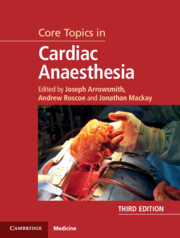Book contents
- Core Topics in Cardiac Anaesthesia
- Core Topics in Cardiac Anaesthesia
- Copyright page
- Dedication
- Contents
- Contributors
- Reviews of the First Edition
- Preface to the Third Edition
- Preface to the First Edition
- Foreword to the First Edition
- Abbreviations
- Section 1 Routine Cardiac Surgery
- Section 2 Anaesthesia for Specific Procedures
- Section 3 Cardiac Catheter Laboratory Procedures
- Chapter 18 Electrophysiological Procedures
- Chapter 19 Procedures for Structural Heart Disease
- Section 4 Paediatric Cardiac Surgery
- Section 5 Cardiopulmonary Bypass
- Section 6 Advanced Monitoring
- Section 7 Transoesophageal Echocardiography
- Section 8 Miscellaneous Topics
- Index
- References
Chapter 19 - Procedures for Structural Heart Disease
from Section 3 - Cardiac Catheter Laboratory Procedures
Published online by Cambridge University Press: 12 May 2020
- Core Topics in Cardiac Anaesthesia
- Core Topics in Cardiac Anaesthesia
- Copyright page
- Dedication
- Contents
- Contributors
- Reviews of the First Edition
- Preface to the Third Edition
- Preface to the First Edition
- Foreword to the First Edition
- Abbreviations
- Section 1 Routine Cardiac Surgery
- Section 2 Anaesthesia for Specific Procedures
- Section 3 Cardiac Catheter Laboratory Procedures
- Chapter 18 Electrophysiological Procedures
- Chapter 19 Procedures for Structural Heart Disease
- Section 4 Paediatric Cardiac Surgery
- Section 5 Cardiopulmonary Bypass
- Section 6 Advanced Monitoring
- Section 7 Transoesophageal Echocardiography
- Section 8 Miscellaneous Topics
- Index
- References
Summary
Historically, the cardiac catheterization laboratory has been used for blood sampling, contrast-enhanced imaging and intravascular pressure measurement to provide diagnostic and prognostic information and to guide surgical intervention. In recent years, technological advancements have made less invasive therapies feasible and driven tremendous growth in percutaneous procedures. While this now encompasses a wide range of cardiovascular interventions, this chapter will focus on percutaneous therapies for structural heart disease, where the anaesthetist is most likely to be involved.
- Type
- Chapter
- Information
- Core Topics in Cardiac Anaesthesia , pp. 137 - 144Publisher: Cambridge University PressPrint publication year: 2020



